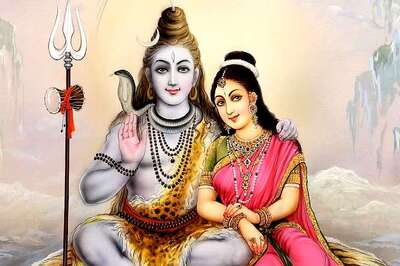
views
Gumla, Jharkhand: The villagers of Nagar Siskari in Gumla district, about 95 km from the capital city of Ranchi in Jharkhand, don’t talk to each other anymore. The irony is that, five months back, after multiple conversations they had, together, killed four- two men and two women- in their own village. They believed only the death of these ‘witches’ would bring peace in their homes.
But peace is the one thing that remains elusive. “We are constantly scared that the police will come and arrest one of us,” said Itwari Topo, one of the villagers.
The police had named 23 in their charge sheet and have arrested 18 so far. “Every single person in that village are responsible for the deaths. Even the kids. Someone beat them with lathi, someone kicked them, other pushed them and hurled abuses. But everyone was involved,” said Bishnudev Chaudhary, SHO, Sisai Thana.
The Fateful Night
The story depends on who you ask.
On the night of July 21, after days of contemplating why there were recurrent deaths in the village, the villagers gathered along with the Ojha, the common name for a ‘black magician’. Everyone was present. The Ojha pointed finger at four elderly in the village and said they were responsible for the deaths. The villagers decided to collect money from every household and conduct a ceremony. The meeting was over.
The police say, later that night, Juley Uraon, the main accused, an alleged criminal and charged in multiple murder cases, called another meeting. He convinced the villagers to kill the four people who allegedly partook in witchcraft. That same night, husband and wife- Suna Uraon and Champa Uraon; two other elderly Piri and Phangni Uraon were brought out of their homes, brutally beaten up with sticks and killed.
The next morning, as the village went silent, four bodies lied around the akhara where the meeting was conducted.
However, the Gram Pradhan, whose house is adjacent to the akhara denied knowing anything about the incident. “I was there in the first meeting, where everyone was present. No one told me about the second meeting. I don’t know when it happened.” According to him, it was the ‘Naxals’.
The other version that multiple villagers narrate involves a peepal tree that one of the victims had allegedly chopped off. “This was the reason that angered the villagers.”
In the last few days as politicians kept visiting the neighbourhood for their election campaigns and speeches, they promised, yet again, more “sarak”. Earlier this week, Union Minister and BJP leader Ravi Shankar Prasad visited Sisai and in his election pitch said that there should be no corrupt government in the “pure land of Birsa Munda”. “No neta has ever talked about witch-hunting and the violence on women. Women issues are never election issues,” said Lakshmi, an activist who works with AALI—Association of Advocacy and Legal Initiatives which works on social crimes and women's rights in the state.

Why is it Not an Election Issue?
Jharkhand is infamous for ‘witch hunting’. The National Crime Records Bureau (NCRB) data reveals that Jharkhand tops the list of states from 2013 to 2016 when it comes to witch hunting deaths. As many as 523 women, besides hundreds of men, were lynched on the suspicion of practicing witchcraft from 2001 to 2016. Between 2012 and 2014, 127 women were killed after being branded witches. There have been 1,857 incidents of witch-hunt from 2014 to June 2016 in the state. Police data showed that between 2016 and May 2019, 123 people, mostly women, were killed for the same reason. In the same period 88 people were killed in Naxal violence.
And yet, it has never been an election issue.
“About six years back witch-hunting cases were considered to be an internal family matter. The police would often connect it to land grabbing and other such cases. The problem is that the state does not identify with hunting as an issue of women violence,” said Reshma, state coordinator of AALI. She explained that the first flaw is in the data.
While the official data of State Crime Records Bureau (SCRB) show 26 people were killed in 2018 and 41 in 2017, Reshma said that their independent survey shows the numbers to be much higher-- 46 in 2015, 39 in 2016 and 34 in 2017. The number of people who have been booked under the Dayan Act has been consistently above 600 since the Act came into place, according to the AALI survey.
About two years back, five women from Kanjia Marhatola village, who were branded witches, were stripped, paraded naked and then hacked to death. A mob of 50 people including children were a part of the horrific killing. The same year, in Dulmi village of Sonahatu block, a 65-year-old woman and her daughter were branded as witches by their relatives. They were allegedly forced to consume human excreta and drink toilet. This was followed by shaving their heads near the bank of Subernarekha river. They were then asked to take baths to “wash their sins”.
In Jharkhand, once branded a witch, the woman is subjected to various forms of torture, often raped, paraded and then brutally killed. Their entire families are ostracised by the villagers. “When a woman’s husband dies, she is forced to leave the village and hide somewhere. Widowed women get targeted as witches because they are most vulnerable,” said Reshma.
“The thought that I can be attacked anytime haunts me. Neither am I safe nor are my daughters,” a woman who had been branded a witch once told Reshma. The activist said that when a woman is branded “Dayan” the entire family faces threat. Usually, it’s the daughters, say Reshma. Called “Dayan’s baccha” they face so much harassment that often they stop going to schools.
After much outrage, the state brought in Prevention of Witch (daain) Practices Act, 2001 to specifically tackle the issue, however, the Act remains toothless. Under the law, the punishment remains a small fine of Rs 1,000-2,000 or imprisonment of three months to one year for branding someone as a witch. While these are non-bailable, the punishment is too meager to stop anyone.

"The police can enter villages to arrest people who are a part of the Pathalgadi movement, but they cannot arrest the miscreants in witch hunt killing?" Reshma asked. “Only Adivasi women get killed, so for the government, it is not relevant," she added. "They talk about vikaas- but how is building bridges and roads changing the mindset of people? How is this development?”
Former Rashtriya Dal chief and minister Annapurna Devi Yadav, who was elected to the Lok Sabha from Kodarma in the 2019 general elections on a BJP ticket, agreed that women issues are often neglected in the state. Devi is one of the very few woman politicians in the state- She had won assembly elections from Koderma in 1998, 2000, 2005, and 2009. During the Lok Sabha elections, the three major parties BJP, Congress and CPI(ML) had fielded only three women candidates; she was one of them. “It’s changing,” Devi said talking about women representation in politics. “We have started a lot of awareness initiatives on the witch-hunting issue and it has helped reduce the number of cases.” When asked why it never becomes an election issue, she says, “Yes, it does not”.
Eighteen years since the state of Jharkhand was formed, no discussion on witch-hunting has ever taken place in the Assembly.
Superstition? Naxals? Education?
It’s been nearly five months since the four elderly were killed in Nagar Siskari village, but the conversations around it are rare and in hushed whispers.
“I think alcohol should be banned. That’s the only way to end such violence,” says one of the villagers. The Mahila Mandal, with the help of the police, had managed to ban liquor in several districts for a year- 2015 to 2016. But then it came back as it led to a loss of livelihood. Meanwhile, the Gram Pradhan keeps insisting it was the ‘party men’ who led to this. “This has never happened in our village before. The villagers were influenced by the Naxals,” he said.
Activists across Jharkhand believe there are multiple reasons for the rampant witch-hunting cases- superstition, illiteracy, property, and health. “But in this village, there are educated people, some of them are employed in government services,” said another villager.
On that fateful night, one of the victim’s son was also forced to beat up his mother. “They said if I don’t beat her they will kill me and the rest of the family,” he confessed before breaking down.
“This is a tactic,” explained Reshma. The villagers get the family members to also participate in the act so that they can blame them when the police come. The family members are often arrested in these cases. Bishnudev Chaudhari, SHO, Sisai Thana, said, “Everyone was involved. They will all be arrested.”
When one of the activists point out to him that the recurring deaths are because it’s a ‘malaria zone’ and the villagers don’t have access to good healthcare, and therefore they end up blaming the easiest target, he says, “It’s neither a malaria zone nor a Naxal zone, it’s just Dayan zone.” The apathy in his voice and laughter that follows is palpable.
On the website of the government of Jharkhand, Gumla is described as a 'malaria-prone zone.' It notes that several cases of death are reported due to malaria every year.
Meanwhile, a rickshaw drives past the police station with loudspeakers blaring: "Phir Modi ko lana hai...."
A day after the incident, one of the victims’ families locked their house and left. They have not returned since. The police camped for a few days at the Anganwadi and eventually left too. Some local politicians came, walked around, and left too. Now all that is left is silence and one question: “When do women stop living in fear?”


















Comments
0 comment